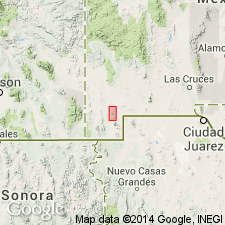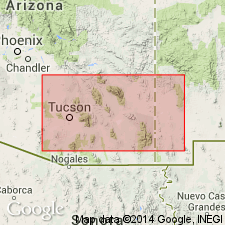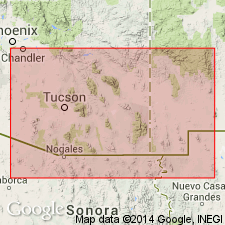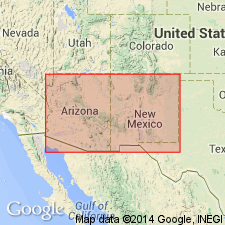
- Usage in publication:
-
- Hidalgo volcanics*
- Modifications:
-
- Named
- Dominant lithology:
-
- Lava
- Limestone
- Shale
- AAPG geologic province:
-
- Pedregosa basin
Summary:
Pg. 532, figs. 2, 4; USGS Prof. Paper 208, p. 20-21, pl. 1, 1947. Hidalgo volcanics of Bisbee group. Consists primarily of basaltic lava flows. Breccia common at the base in Little Hatchet Mountains, and a little pyroclastic material present at other horizons. Locally contains 200 feet of thin-bedded light-gray and red limestone, red and green shale, and some conglomeratic layers. Exposed thickness ranges from 900 to 5,000 feet, the wide range being due to disconformities at top and bottom. In Little Hatchet Mountains, disconformably underlies Howells Ridge formation (new) of Bisbee group; disconformably overlies Ringbone shale (new), and in some places Broken Jug limestone (new), both of Bisbee group. Age is Early Cretaceous (Trinity). Report includes geologic map.
Named from Hidalgo County, southwestern NM, over which the formation seems to be widely distributed. In Eureka district, Little Hatchet Mountains. [According to GNU records (USGS DDS-6; Denver GNULEX, Mar. 18, 1986), type locality not designated.]
Source: US geologic names lexicon (USGS Bull. 1200, p. 1753); supplemental information from GNU records (USGS DDS-6; Denver GNULEX).

- Usage in publication:
-
- Hidalgo volcanics
- Modifications:
-
- Overview
Summary:
Tentatively correlated with Tertiary volcanics in Arizona.
Source: GNU records (USGS DDS-6; Denver GNULEX).

- Usage in publication:
-
- Hidalgo Volcanics*
- Modifications:
-
- Age modified
- Revised
- Overview
- AAPG geologic province:
-
- Pedregosa basin
- Basin-and-Range province
Summary:
Is formation in Little Hatchet Mountains, Hidalgo and Grant Cos, NM in Pedregosa basin and Basin-and-Range province. Is not considered part of Bisbee Group in this area; changed from previous work by Lasky (1947). Bisbee not used locally in this paper. Disconformably overlie Ringbone Shale (Campanian, Upper Cretaceous). Thickness (following Lasky, 1947) may exceed 5,000 ft. Age changed from Tertiary (Richard and Courtright, 1960) to Campanian (Late Cretaceous) on basis of correlation with lower part of Salero Formation in southeastern AZ. [See fig. 5 for regional correlation.]
Source: GNU records (USGS DDS-6; Denver GNULEX).

- Usage in publication:
-
- Hidalgo Volcanics*
- Modifications:
-
- Geochronologic dating
- AAPG geologic province:
-
- Pedregosa basin
Summary:
Hidalgo Volcanics includes rocks of Late Cretaceous, Paleocene, and Eocene or Oligocene ages, based on Fission-track ages on zircons.
(1) Sample from Little Hatchet Mountains area (type area), Hidalgo Co., NM; age 69.6 +/-3.2 Ma;
(2) Samples from Pyramid Mountains area, Hidalgo Co., NM; age 67.3 +/-7.1 Ma and 54.9 +/-2.7 Ma;
(3) Samples from Peloncillo Mountains and vicinity, Cochise Co., AZ; age 44.7 +/-2.7 Ma and 27.5 +/-4.8 Ma.
[These variations in age suggest that the rocks of Pyramid and Peloncillo Mountains areas may not correlate with the Hidalgo Volcanics in its type area, and that there the age of the Hidalgo is Late Cretaceous to Paleocene.]
Source: Modified from GNU records (USGS DDS-6; Denver GNULEX).
For more information, please contact Nancy Stamm, Geologic Names Committee Secretary.
Asterisk (*) indicates published by U.S. Geological Survey authors.
"No current usage" (†) implies that a name has been abandoned or has fallen into disuse. Former usage and, if known, replacement name given in parentheses ( ).
Slash (/) indicates name conflicts with nomenclatural guidelines (CSN, 1933; ACSN, 1961, 1970; NACSN, 1983, 2005, 2021). May be explained within brackets ([ ]).

